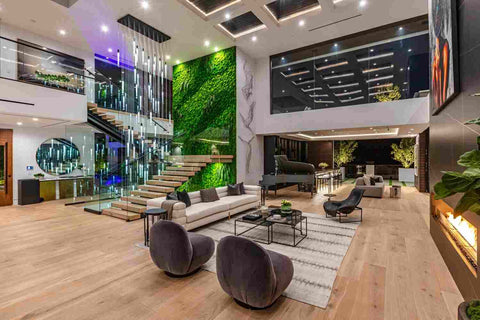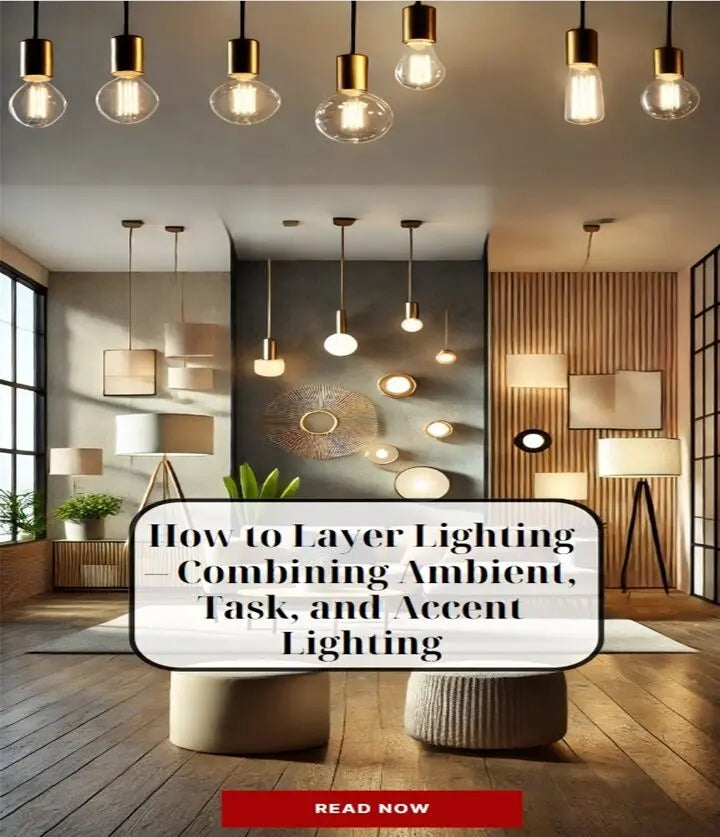
Are you looking to transform your home into a functional, versatile, yet comfortable space where solace is guaranteed? The key lies in how you incorporate lighting in your residence.
Layered lighting is an interior design technique that combines ambient, task, and accent light fixtures in a space. It helps to enhance the functionality and visual appeal of your home. Unfortunately, most homeowners aren’t aware of this technique and how to use it.
This guide explains how to layer your lighting and how you can combine ambient, task, and accent light fixtures to illuminate your home.
Understanding the Different Types of Home Lighting Design

Your home’s interior design can be significantly elevated through layered lighting. However, knowing how to select the best light fixtures for your space is also crucial.
Ambient, task, and accent light fittings are three basic options you can explore for your home. Here’s how each works and examples of fixtures you can use to achieve proper layered lighting.
- Ambient: This lighting provides general illumination in any room. It’s typically the main layer and helps determine how much more light you need in the space. Ideal light fixtures for this lighting choice include ceiling lights and recessed down lights.
- Task: Specifically designed to provide focused light to help carry out fixed activities like reading and chopping vegetables. It helps to eliminate any shadows that might have been created by your ambient lighting. Common fixtures include desk lamps and hidden LED strip lights.
- Accent: This is the best lighting to use if you want to add character, depth, and dimension to your space. Wall lights are typically a great option for this light design scheme.
Light Layering Techniques You Can Use in Your Home
The approach you use to layer your lighting can determine the ambiance in your home. Listed below are different layering techniques you can employ and the layout used to achieve it.
Vertical Layering

This approach involves positioning different light sources at varied heights within the same space. It works by drawing the eye upward or downward depending on where your eyes land. The layout provides a beautiful effect helping you create dimension and depth in the room.
Vertical layering is ideal for homes with high ceilings. You can install a chandelier to provide ambient lighting, add some wall sconces to accentuate and highlight the home’s décor, and finally place some floor lamps. This technique provides the perfect blend of functionality and aesthetics by ensuring even illumination and infusing style into the space.
Depth Layering

A complex interplay and balance between the foreground and background of a room. This is the basis of the depth layering technique. It involves a lot of experimentation which involves placing your light sources at different heights and distances until you find the best setting for your home.
You can position lights behind objects for optical illusion and to add character to the space. LED strip lights are perfect for depth layering. Inspect your layout from different angles to assess whether the light design works for your space.
Horizontal Layering

Akin to its name, this technique involves arranging different light fixtures at the same eye level all across the room. It helps to open up the space and make it appear larger than it is. If you’re looking to draw your guests’ attention to a particular décor piece or wall texture, horizontal layering is the best approach to employ.
Detailed Guide on How to Layer Your Home’s Lighting
Incorporating layered lighting in your home is a complex process. But, it can be done. Here are some steps to help you get your layered lighting right:
- Determine your ambient lighting source. This will be your overhead light.
- Assess your space and select the layering technique you’ll use in the home.
- Determine the luminance level you need in the room.
- Carefully assess your lighting plan from different areas in the home to ensure that all areas are covered.
- Install the light fixtures and test them out to ensure that they’re practical and ideal for the space.
- Where necessary, make the changes by adjusting light fixture placement, color temperature, or light intensity to achieve the desired ambiance.
Pro Tip!
There is an additional type of lighting you can add to your home – decorative lighting. If you’re looking for a light fixture that can add a decorative element to your home, this option is ideal. You can spice up the look of your home with a few statement light fixtures for a mesmerizing allure.
Factors That Can Determine How You Layer Your Lights
The choice of where and how you place your lighting fixtures can significantly determine your home’s atmosphere. Here are a few factors you should consider to help get your layered lighting right.
Natural Light

When incorporating layered lighting into your home, pay attention to the amount of natural light that streams into the space. Glass doors, windows, and skylights can provide ambient lighting throughout the day. Assessing it can help you notice areas that may need more light and help you plan accordingly.
Size of Your Room and Ceiling Height

These two aspects can affect the outcome of your layered lighting design. Homes with high ceilings may require you to follow the vertical layering technique to ensure sufficient illumination. Meanwhile, residences with limited space and lower ceilings are better suited for depth layering.
Home Electrical Set Up
Your home electrical wiring system can pose some challenges to your lighting design. You should therefore carefully evaluate it to ensure it can support the changes you want to make. Be aware that the additional lights you want to introduce into the home will require more power outlets. You might have to stick to ceiling lights if you have a few wall sockets. Recessed lights and strip lights are also a great alternative.
Alternatively, you can hire a professional to remodel your home’s electric system. They will guide you on the proper placement of new light sources. Be aware that you can also opt for smart lighting if you don’t want to make changes to your current wiring plan.
Embrace Layered Lighting for the Best Home Lighting Design Scheme

Incorporating layered lighting into your home is a smart idea. With the information listed in this article you’re well on your way to lighting up your home like an interior design pro. You can contact Seus Lighting to buy and enquire on a range of light fixtures to help actualize your home’s layered lighting design plan.


